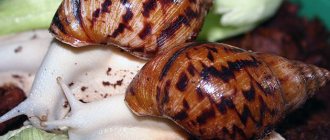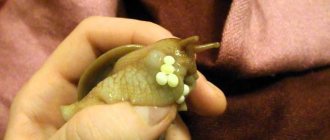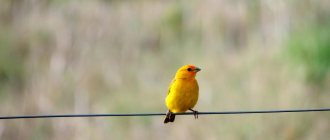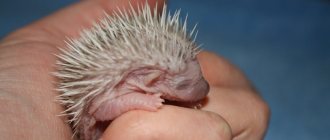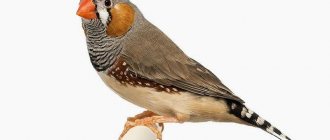Exotic lovers are increasingly keeping snails as pets. Why not, inexpensive, quiet, no trash - ideal pets.
Usually in the home terrarium you can find Achatina, also known as African land snails. You can recognize them by their massive shell with 7-9 turns. Depending on the species, the color can vary from light to dark brown with or without black stripes, spots. The mollusk lives up to 10 years and throughout its life it increases in size, growing to 20 or more centimeters. Achatina are nocturnal; they crawl out of their shelters approximately 2 hours after sunset.
Gastropods have long-term memory; they remember where they found food and which one they liked best, and often return to the same shelter to sleep. Over time, snails remember their owners and even distinguish them from other people.
Conditions for keeping snails
For a snail you need a terrarium with a good quality substrate, coconut shavings are best. The height of the soil should be such that the snail can burrow completely into it. The volume of the aquarium per individual is at least 10 liters. It is covered with a lid with ventilation holes on top.
The optimal temperature for a snail is 22-28°C. Additional lighting is not needed; moreover, direct sunlight and drafts are strictly contraindicated for them. To maintain optimal air humidity, once a day the soil should be sprayed with a spray bottle and monitor the behavior of the pet: if the aquarium is too dry, the snail will stay in the shell for a long time, or even close its lid, and if it is too humid, it will sit on walls of the terrarium. Achatina loves to swim, so you can build small baths for them.
Types of aquarium shellfish
In pet stores you can find a huge variety of species of such mollusks, they are all different, they look different, but all of them, without exception, are remarkable in appearance and will decorate any aquarium ecosystem:
Ampularia
Ampularia are considered the most common aquarium mollusks. They are quite recognizable: their shell is always yellow, round, and its diameter is approximately 5-7 cm. Dark or striped shells in such snails are quite rare. This is an unpretentious creature that does not require any special care. Everything you need to know is described below:
- the temperature of the water in which the ampularia is kept should be between 18-27 degrees;
- a filter must be installed in the reservoir;
- food for such shellfish should only be soft (boiled vegetables, bread, fish flakes);
- there should be a lot of plants in the aquarium, since these mollusks will actively eat them;
- The water must have an optimal calcium content so that the ampoule always has a strong shell.
By the way, ampullaria, unlike their relatives, are heterosexual, which means that several individuals will be required to breed them. It is best to have 3 or 4 of these mollusks, since it is almost impossible to determine their sex.
The proximity of such snails to small harmless fish or catfish is acceptable, but it is better not to add them to predators.
Coil
Such mollusks do not require a pair, since they are true hermaphrodites and are capable of laying eggs without the help of a partner. By the way, they lay eggs on the leaves of aquatic plants.
These mollusks are found both in aquariums and in the wild . The difference between them can be seen in the size of the shell: domestic coils have a maximum size of 2 cm, and wild ones - 3 cm.
These snails are also interesting because they have gills on their protruding mantle. By the way, a good filter should be installed in an aquarium with coils, since these creatures very quickly deplete the oxygen reserves in the water.
To control the number of such snails, it will be enough to remove some of the plants from the aquarium and also give them less food.
Fiza
Snails such as Physa have a shell of a different shape - it is pointed. With such a shell, the mollusk is able to crawl even into the most inaccessible places and clean out debris there. Their distinctive features are as follows:
- they have pulmonary breathing;
- shell color is yellow or brownish-brown;
- they are able to remove even green plaque from the walls of the aquarium, and bacterial films from the surface of the water.
The temperature of the water for keeping the fish should be equal to degrees, and the hardness of the water should be in the range of 8-18 dH, since in soft water its shell can collapse.
Just like other mollusks, physes reproduce quickly by laying eggs on plants. But their numbers are successfully controlled by aquarium fish.
Melania
Melanias can get into the aquarium even with purchased plants. They play a significant role in aquarium hygiene, since they live mainly in the soil, where they actively clean it of bacteria and biological contaminants.
The shape of the melania shell is always conical, but rounded on the sides. Its color is greenish-gray, there are specks. An adult reaches a size of 3.5 cm. Interestingly, for such a mollusk it has a very hard consistency, which makes it invulnerable to predatory fish .
The optimal water temperature for such a snail is 18-28 degrees; in cold water it can die . As for water hardness, as well as nutrition, melania is completely unpretentious. These are viviparous snails that carry eggs, and then young animals emerge from these eggs.
Neritines
Neritina is a tropical mollusk, so it is necessary to care for it with special attention:
- water temperatures - from 24 to 27 degrees;
- water hardness - medium or high;
- water acidity - about 7.5;
- water should be changed frequently;
- For a comfortable life, Neretina requires a large aquarium with a minimum of 40 liters of water.
Neretina are not large in size - only 2.5 cm.
The shell can be any color, from bright olive to deep black with golden stripes .
They can live in both freshwater and saltwater environments, but reproduction occurs only in saltwater environments.
Helena
Helena is a real predator who, in the absence of food, can calmly feast on one of her relatives. By the way, it is with its help that many solve the problem of the large number of other snails.
The shell of such a mollusk has a yellow tint and a ribbed surface ; it also has a spiral stripe. Helena's dimensions are very modest - only 2 cm . The capacity for fertility is also modest.
Helena needs soft soil, as she loves to burrow into it.
Tylomelania
Tylomelania is a kind of aquarium giant, as its size reaches 12 cm . This mollusk is very beautiful; it has an unusually shaped shell, sometimes smooth, sometimes with spines. The color of both the shell and the mollusk itself can be varied.
For tilomelania to feel good, it needs the following conditions:
- they must live separately, proximity to other species of snails is excluded;
- the aquarium must have a length of at least 80 cm;
- the water should not be hard and have high acidity;
- water temperature - from 20 to 30 cm;
- these are voracious creatures, they are omnivores and they require a lot of food, and they need to be fed at least 2-3 times a day;
- in the aquarium it is necessary to equip a shelter for such snails, because they do not like bright light.
Since such mollusks require a lot of space for a full life , you should not plant too many plants and other decor in the aquarium.
No aquarium can do without snails, because they are not only beautiful and unusual creatures, but also brilliant orderlies who will rid their ecosystem of pollution and plaque.
Snail care
Caring for an unpretentious pet is not difficult. The aquarium is cleaned approximately once a week, removing plaque from the walls with a soft brush. The soil is replaced as it gets dirty and completely changed several times a year. Pets are periodically bathed under running warm water and, if necessary, the sink is cleaned with a brush. After feeding, be sure to remove any remaining food to prevent the formation of rot and mold in a warm, humid aquarium.
Types of snails
Ampularia
First of all, it must be said that there are several main types of snails that can get into your aquarium.
Ampoules.
These are the indigenous people of South America who emigrated to old Europe to live in aquariums. Ampoules are very reminiscent of pond snails known to everyone from childhood. These beauties love to travel, so they are not very suitable for lovers of open aquariums or for those who, for various reasons, leave the water house open. These travelers love to get out of the aquarium, so be prepared to meet them anywhere.
Melania
Melania.
They love to sort through the soil. Therefore, the size of the aquarium soil fractions is important for such snails. This is where you won’t have any questions about why you need soil in an aquarium. This snail digs through everything and everyone, thus protecting plant roots from stagnation. But the soil should not be too small or too large.
Physus snail
Snail phys.
A very small snail with an almost round “box”-shell. Most often, such a miracle ends up in the aquarium along with newly acquired algae. This snail is remarkable in that it can produce thin and very strong threads. She glues one end of this thread to a pebble at the bottom of the aquarium, and the other to the top leaf of some aquarium plant. And thus the snail moves around the aquarium, as if on an escalator. Physes are often found near the surface of the aquarium, so their use may be to remove the film that often forms near the surface of the water. Physa reproduces very willingly, so if it is present, you need to very vigilantly control the number of individuals. Otherwise, the aquarium will turn into an overcrowded communal apartment.
Feeding the snail
The diet of a domestic snail includes any fruits and vegetables (except citrus fruits), greens, small daphnia crustaceans, bread and even milk. To build a shell, they need calcium, which means there should always be chalk or cuttlefish shell in the terrarium. You can also sprinkle the soil with eggshells ground in a coffee grinder. Snails should not eat salt, sugar, spicy or fatty foods. It is not recommended to give small snails loose fruits; there have been cases when snails flew away with their heads buried in a banana and suffocated.
Are snails useful in an aquarium?
Snails in an aquarium can bring both benefits and some harm or inconvenience.
Benefit:
1. Snails, along with shrimp and some fish such as mollies, are aquarium orderlies.
The sanitary function of snails is to clean the aquarium from the remains of the aquarium fish’s meal, from dead parts of plants and algae fouling. Thus, snails help maintain biological balance in the aquarium.
2. Some types of snails, swarming in the soil, prevent it from souring.
Harm:
1. Snails, like fish, also crap in an aquarium.
2. Snails usually reproduce very quickly, so it’s worth taking care in advance to control their numbers.
An uncontrolled number of snails will not lead to maintaining the biobalance in the aquarium, but, on the contrary, will destroy the already fragile biological balance in the artificial reservoir.
3. If there is a shortage of leftover fish food in the aquarium, snails may begin to eat the aquarium plants
4. Snails can easily introduce various diseases into an aquarium, so under no circumstances should you catch snails in natural bodies of water. In connection with this circumstance, the concept of quarantine is applicable to snails, as well as to fish.
Reproduction of domestic gastropods
By nature, snails are hermaphrodites, but for reproduction they still need a partner of the same species. Alone, they can lay eggs, only they will be empty. When the time comes for procreation, the snails come together and exchange seed through a special organ on the cheek. After some time, both snails lay fertilized eggs. Their size and quantity depend on the type of mollusk.
Or maybe it’s not necessary after all? Cons of snails
The number of these mollusks must be regulated very vigilantly, since along with these “slowfish” additional waste appears in the aquarium. In turn, this affects the biobalance to one degree or another. Are you ready for such measures? Snails are plant lovers in the aquarium. That is, those who like to eat them, chew them, gnaw them. In a word, this also needs to be taken into account. Together with the beautiful shell that the snail drags around the entire aquarium, it can bring one of the rotten diseases into your aquarium.
Treating aquarium fish is not the most pleasant job, so this is also a reason to think about it. It is not always possible to completely get rid of snails in an aquarium. And that's why. The fact is that some species lay clutches with eggs under the leaves of plants or in secluded corners of the aquarium. This, of course, may not be noticed, and then again you will see small mollusks among the snags. Whether or not to have snails in your aquarium is an open question. You should inspect plants very carefully when you purchase them. There should be no clutches of eggs there, otherwise new inhabitants will soon appear in your aquarium. Many are happy to populate their water mansions with such “tenants” because they appreciate their beauty and slow grace.
